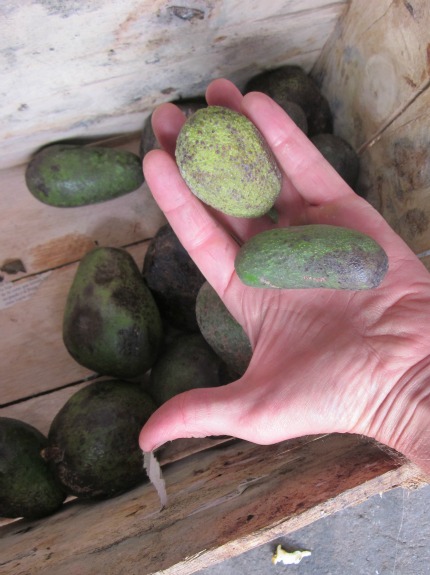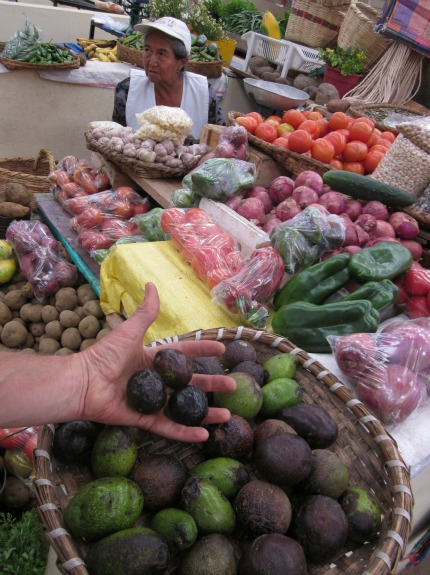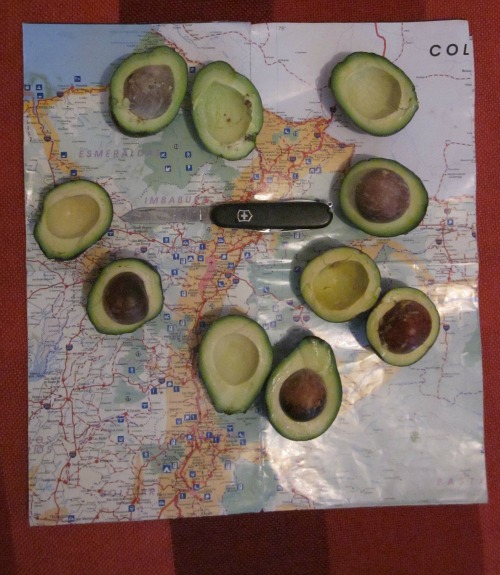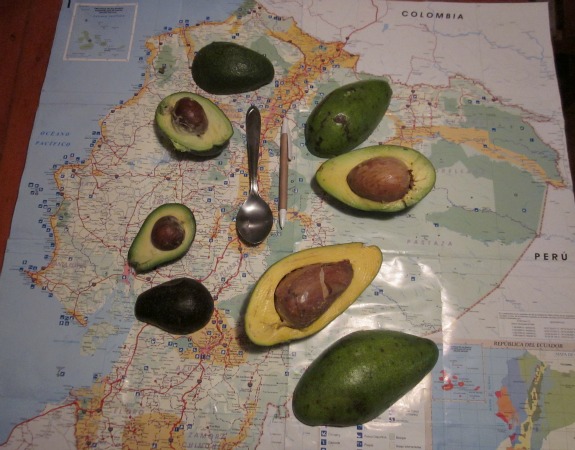What Makes These Avocados Different From All Others?
The spectrum of the fruit here is almost as varied as the people who grow them, and for avo advocates, Ecuador is an excellent place to go tasting
Four avocados found in a the city center market in Cuenca. From top left, Guatemalteca, Costeno, Lojano and “negro.” Photo by Alastair Bland.
Long before there was guacamole, California rolls or the Super Bowl, there were avocados. The species–Persea americana–is native to Mexico and Central America and has been widely planted and naturalized in the Caribbean and South America. While vast orchards of trees–most of them genetic duplicates of the Hass variety and several others–grow in the world’s main regions of production, like California, in places less affected by the homogenous sprawl of commercial agriculture, hundreds of different varieties exist. In Ecuador, avocados of endless shapes, colors and sizes are sold in the central town markets. Certain varieties are favored and cultivated widely, but the spectrum of avocados here is almost as varied as the people who grow them. For avo advocates, such a selection of varieties makes touring the local markets a source of intrigue and offers a fine opportunity for a varietal tasting of the fruit that was once called “poor man’s butter.”
But the systematic food scientist hoping to set the table for an organized tasting also must know the names of his samples–and, unfortunately, the avocados of Ecuador elude such labeling. That’s because different varieties of avocado either don’t have names or because the vendors simply don’t know what they’re selling.
“This is just an avocado,” the vendor tells me carelessly at a market in Loja.
“But look,” I counter. “Those over there are different, and those, too, are black, not green. And some are tiny, like limes. There are many, many types, and they have names. So, what is this one called?”
She shrugs and laughs at her friends, who seem amused by my insistence and the pen and paper in my hands.
“Green avocado,” she says.

Richard Warner, an American-Brazilian currently traveling in Ecuador, grips an enormous avocado on a tree in Vilcabamba at the Rendezvous guesthouse. The property manager said the fruits were still two months from ripeness and might weigh four pounds when harvested. Photo by Alastair Bland.
Other vendors commonly name their avocados as “Guatemalteca”–meaning Guatemalan. This, however, is not a variety name but a broad category of avocados that includes many varieties. Vendors have shown me Guatemalteca avocados with green pebbled skin, shiny, black, smooth skin and polished lime-green skin. I have seen Guatemalteca avocados both big and small, and I have tasted ones with watery, fruity flesh and fatty, thick, rich flesh.
I have pointed out these differences to fruit dealers who give this simple label to all their avocados, and they have answered, “Oh, that is Guate-negro, and that is Guate-verde, and that is Guate-pequeno. But that’s not important. Four for one dollar!”

These small avocados found in the central market of Pujili resembled fingerling potatoes. Photo by Alastair Bland.
Actually, it is important to get variety names straight before a tasting–and only occasionally are vendors helpful. In the town of Paute, about 30 kilometers northeast of Cuenca, I stopped in at the central market, having been told that some very fine avocados are grown here. I saw nothing especially remarkable–mostly just small to tiny avocados, both green and black, with thin, brittle skins and oily flesh. But one saleslady named her avocados as “Pautena.” Fresh data! I hungrily scribbled down this name–probably given to a local variety, born in this region and named for the town. Problem was, her avocados were all different sizes, colors and shapes, yet she insisted they had come from the same tree.

This shapely array of avocados, found in a market in Paute, came from the same tree, according to the woman selling them. Photo by Alastair Bland.
So, with proper names on them or not, here are some avocados you may taste in Ecuador.
Guatemalteca A word commonly heard in avocado conversations in Ecuador, Guatemalteca is the name applied to numerous avocado varieties by the vendors who sell them. This becomes a point of frustration for one trying to differentiate the varieties by actual name, yet to avocado experts the label carries a seed of truth. For the Guatemalan avocado is one of three subspecies of P. americana (the other two are the Mexican and the West Indian). Guatemalan avocado trees generally produce large fruits with pebbly, thick skins and fatty flesh. But there are hundreds of varieties of this subspecies, but never did I get much past the blanket term “Guatemalteca.” The avocados I found carrying this label had skins ranging from thin, shiny and black to thick, pebbly and green. Flesh was usually on the delicious and creamy, though a few Guatemalteca avocados were of the watery sort. I licked my spoon clean, confused every time.
Costeno An elongate, smooth, light green skinned avocado, the Costeno–if it really is the Costeno–has light, low-fat flesh that is fruity and mild. Such avocados are often reserved in Ecuador for use in sweeter preparations–such as blended with milk and sugar–but for many tasters, avocados like the Costeno will lose out when compared to the rich, fatty avocados of a proper Californian guacamole pot.
“Negro” With no given name beyond its color, this small, shiny fruit has skin that appears almost like asphalt–a mottled, blackish-brown. The flesh is nutty but plain, slightly bitter, and just a little watery. Be warned that the same avocado may be called a Guatemalteca.
Lojano I found this avocado in Cuenca, at a fruit stall on the east side of town. A very large and elongated avocado, with smooth shiny green skin, its flesh was a unique yellowish-orange and of buttery, fatty consistency. The Lojano was one of the very best I tasted–and four of these giants cost only a dollar. Praise Ecuador!
Criollo Another smooth-skinned, lime-green avocado like the Lojano and Costeno, the Criollo was found in the basket of a street vendor in Loja. The pit is huge and the meat lacking both in quantity and oil.
Pautena The town of Paute, in the mountains east of Cuenca, is renowned by some locals for its avocados, which may be grown nowhere else. The leading form seems to be a small, shiny black avocado not much larger than a golf ball and with dense, sticky flesh.

These small avocados from Paute contained large pits–a negative trait for commercial growers. However, their fatty, buttery flesh made up for the lack of it. Photo by Alastair Bland.
Other avocado names you may hear in Ecuador:
Mantequillo, nacional, paisano.
Peru–Another Place to Hunt:
The markets of Peru yielded some spectacular finds, of avocados both strangely shaped and of tremendous size. In the northern towns, one may find avocados weighing about four pounds and the size of footballs. In Huarmey, watch for a vendor in the central marketplace with a basket full of avocados shaped like cashew nuts.
Almost an avocado: The coyo is a green, pear-shaped fruit that hangs from large tree that belongs in the same genus as the avocado. The fruit is not commercially cultivated, but the intrepid searcher who asks questions and knocks on doors may find their way to a coyo tree. I, for one, did not. Good luck.
/https://tf-cmsv2-smithsonianmag-media.s3.amazonaws.com/accounts/headshot/Off-Road-alastair-bland-240.jpg)


/https://tf-cmsv2-smithsonianmag-media.s3.amazonaws.com/accounts/headshot/Off-Road-alastair-bland-240.jpg)